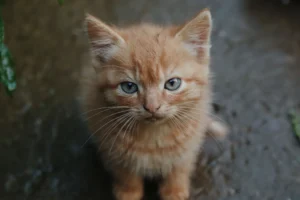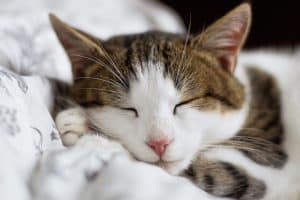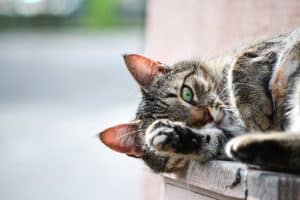Have you ever wondered why cats can’t go outside? The answer may surprise you.
Indoor vs. Outdoor Safety
Many cat owners wonder why cats can’t go outside, but the truth is, the great outdoors can be a dangerous place for our feline friends. Traffic accidents are a significant risk for outdoor cats, as they may not be familiar with navigating busy roads. Predators like coyotes or even larger birds can pose a threat to cats who venture outside. Additionally, outdoor cats are more exposed to diseases spread by other animals, such as feline leukemia or rabies.
When it comes to keeping your cat safe, it’s best to provide them with a secure and enriching indoor environment. By creating a stimulating indoor space with toys, climbing structures, and window perches, you can keep your cat happy and healthy without the risks of the outdoor world.
Behavioral Issues
Allowing your cat to roam outdoors might seem like a good idea, but it can lead to behavioral problems that you may not have anticipated. Outdoor cats may exhibit aggression towards other animals in their territory, leading to fights and injuries. They may also engage in territorial marking, such as spraying, which can be frustrating for both cat owners and neighbors.
To prevent these behavioral issues, consider enriching your cat’s indoor environment with interactive toys, scratching posts, and regular play sessions. Providing your cat with mental stimulation and physical activity can help alleviate the desire to go outside and engage in potentially harmful behaviors. Remember, a happy indoor cat is a safe and content cat.
Environmental Hazards
When it comes to cats going outside, it’s important to be aware of the environmental hazards that can pose risks to their health and safety. Toxic plants are a major concern as many common outdoor plants like lilies, azaleas, and chrysanthemums can be toxic to cats if ingested. It’s crucial to research the plants in your area and ensure your furry friend stays away from them. Moreover, pesticides used in gardens or on lawns can also be harmful to cats if they come into contact with them. Cats can easily absorb these chemicals through their skin or by grooming themselves after exposure. Extreme weather conditions such as heatwaves or cold snaps can also be dangerous for outdoor cats, who may not have adequate shelter or protection from the elements. It’s best to keep your cat indoors to avoid these potential dangers.
List of common outdoor hazards for cats:
- Toxic plants: Lilies, azaleas, chrysanthemums
- Pesticides: Harmful chemicals in gardens or lawns
- Extreme weather: Heatwaves, cold snaps
Always prioritize your cat’s safety by keeping them indoors where they are protected from these environmental hazards.
Legal Considerations
When it comes to cats going outside, it’s not just environmental hazards to consider. There are also legal considerations that may restrict or prohibit cats from roaming freely outdoors. Many local laws or regulations focus on pet ownership and public safety, aiming to protect both pets and the community. In some areas, there are ordinances that require cats to be kept indoors or on a leash when outside to prevent them from wandering and potentially causing harm or nuisance to neighbors. By following these laws, you are not only ensuring your cat’s safety but also being a responsible pet owner in your community.
Remember to check with your local authorities about any specific ordinances that may apply to your area regarding outdoor cats. It’s always better to be informed and abide by the regulations in place for the well-being of your furry companion and the community.
Health Benefits of Indoors
Keeping your furry feline indoors comes with a plethora of health benefits. Reducing the risk of injury is a significant advantage since outdoor excursions can lead to accidents, encounters with other animals, or exposure to harmful substances. Indoor cats are also less susceptible to diseases spread by other animals or parasites. Promoting overall health and well-being is another plus. With a controlled environment, you can ensure your cat has a balanced diet, regular vet check-ups, and a safe space to roam without the dangers of the outdoors.
Enrichment Activities
To prevent boredom and promote mental and physical stimulation for your indoor cat, there are several enriching activities you can incorporate into their daily routine. Interactive toys, such as puzzle feeders or laser pointers, can keep your cat engaged and mentally sharp. Cat trees or shelves provide vertical space for climbing and exploring, satisfying their natural instincts. Rotating toys to keep things interesting, and setting up a window perch for bird-watching can also provide entertainment. Additionally, consider daily play sessions and training exercises to keep your cat active and healthy.
- Create a DIY obstacle course: Use household items like cardboard boxes or paper bags to set up a fun obstacle course for your cat to explore.
- Hide treats around the house: Encourage your cat to use their sense of smell and hunting instincts by hiding treats in different areas for them to find.
- Invest in a cat fountain: Cats are attracted to running water, so a cat fountain can provide mental stimulation and encourage hydration.
Remember, a happy and healthy indoor cat is a cherished companion for many years to come.
Training Techniques
So, you’ve decided to keep your feline friend indoors, but you’re worried about how to keep them happy and well-adjusted. Don’t fret – with the right training techniques, you can help your cat thrive in their indoor environment. Start by litter box training them early on, ensuring they have easy access to their designated bathroom spot. Positive reinforcement is key – reward good behavior with treats and praise to encourage your cat to continue behaving well. Remember, consistency is key when it comes to training your furry companion. With a little patience and perseverance, your cat will adapt to their indoor lifestyle in no time.
Creating a Safe Outdoor Space
Now, if you’re looking to give your cat a taste of the great outdoors without the risks that come with it, consider creating a safe outdoor space for them to enjoy. One option is to set up an enclosed catio – a screened-in patio specifically designed for cats. This allows your furry friend to experience the outdoors safely while keeping them protected from potential dangers like cars or wild animals. Another option is to invest in a secure outdoor enclosure that you can place in your yard. This provides a larger space for your cat to roam around in while still keeping them safe and secure. With a safe outdoor space, your cat can enjoy the fresh air and sunshine without the risks of roaming freely outside.
Tips for creating a safe outdoor space:
– Ensure the enclosure is escape-proof with secure walls and a strong roof.
– Add cat-friendly plants and climbing structures for your feline friend to explore.
– Provide shade and shelter to protect your cat from the elements.
– Regularly inspect the enclosure for any wear and tear, ensuring it remains in good condition.
– Supervise your cat while they’re in the outdoor space to keep them safe at all times.
Fun Facts About Cats
Did you know that cats have a unique collarbone that allows them to always land on their feet when they fall? This special adaptability, known as the “righting reflex,” helps them maintain their balance and avoid injury. Cats are also crepuscular, meaning they are most active during dawn and dusk. So, if your furry friend seems to have bursts of energy at these times, it’s completely normal!
Discover the reasons why keeping cats indoors is the best choice for their safety and well-being.
When it comes to the safety and well-being of your beloved feline friend, keeping them indoors is often the best choice. Outdoor cats face a range of dangers, from traffic accidents to encounters with predators and exposure to diseases. By keeping your cat indoors, you can protect them from these risks and ensure they live a long and healthy life.
One of the key reasons why cats are better off inside is the reduced risk of injury. Cats that roam outdoors are more likely to get into fights with other animals, leading to scratches, bites, and infections. Additionally, outdoor cats are at risk of being hit by cars or becoming lost or stolen. By keeping your cat indoors, you can provide a safe environment where they can avoid these potential dangers.
Another important aspect to consider is the impact on wildlife. Outdoor cats are natural hunters and can have a significant impact on local bird and small mammal populations. By keeping your cat indoors, you can help protect wildlife and ensure the delicate balance of your local ecosystem remains intact.
Furthermore, keeping your cat indoors can also prevent them from contracting diseases that are commonly spread through interaction with other animals. Outdoor cats are at a higher risk of coming into contact with parasites, infectious diseases, and toxins. By keeping them inside, you can minimize their exposure to these hazards and keep them healthy and happy.
In conclusion, while it may be tempting to let your cat roam outside, the best choice for their safety and well-being is to keep them indoors. By providing a secure and enriching indoor environment, you can ensure that your feline companion stays healthy, happy, and safe.
Alex, a passionate animal lover, has experience in training and understanding animal behavior. As a proud pet parent to two dogs and three cats, he founded AnimalReport.net to share insights from animal experts and expand his knowledge of the animal kingdom.




